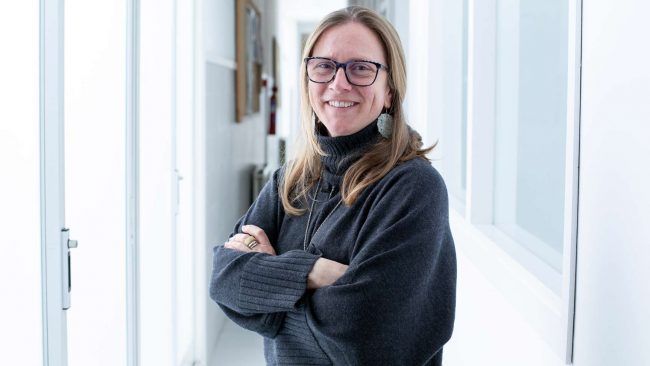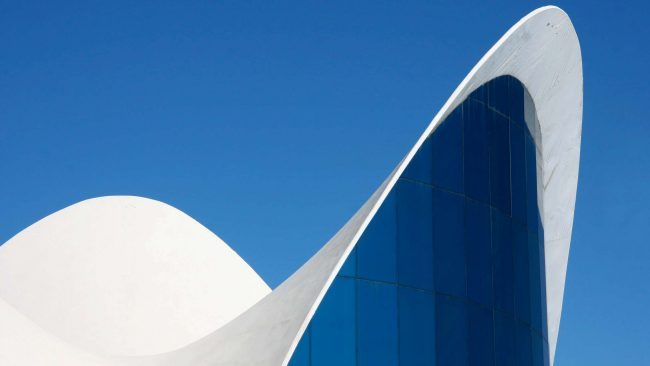Mathematics is one of those subjects that many people are afraid of, dreading its impossible concepts: variables, calculus and fractal geometry. But then you haven’t met the person who teaches this at ESET, CEU’s school of architecture.
She has a PhD in mathematics, so she was always bound to love numbers, but she also sees teaching as a vocation. After you talk to CEU lecturer Lucía Hilario, it’s obvious why students end up finding numbers so interesting when studying with her! In our conversation with Lucía we explored the meaning of maths, what its practical applications are and, most especially, how maths has been given an international and innovative twist at the University. The solution to that equation was to use an approach called COIL – Collaborative Online International Learning.

Lucía, you’ve been one of the first to take up the gauntlet of this ground-breaking COIL initiative and you’ve done so boldly, with modules for Mathematics, Theory of Architecture, and Construction of Foundations and Structures. What led you to include this module in your course?
The reason is clear: it’s down to the kind of students we have, who are from all over the world. For them, being able to interact with people at the Florida International University is very positive, because it makes their experience here even more international. It’s something that makes the internationalization of ESET that much more tangible.
Personally, as soon as this project was proposed, I knew what I wanted to do. I teach on both the Business Management and Architecture degrees, but at ESET the group of students I teach is smaller. So, given their international profile as well, it made it that much easier to try out my first COIL module with them.
This module forms part of the Mathematics course. Was it easy to incorporate it within the course?
The Mathematics course is taught over both semesters of the first year, and I always try to give the students the mathematical tools needed for physics and structural calculations. And then I also look at the kind of maths that really connect with the professional practice of architects: we study the golden ratio, the catenary curve, fractal geometry, etc. And I’m always trying to encourage learning by doing. So, for example, soon we’re going to visit the Ciudad de las Artes in Valencia, so that I can get an architect to explain what kind of surfaces have been used in its construction.

I don’t think that my course is one of those that undergraduates hate because I always try to give them tools that they can use in architectural projects, such as geometry. It’s also true that the degree of knowledge students have when starting the course can be quite uneven, and it’s important to bear this in mind. So, in the first few months, I focus on finding a balance between the stronger and weaker students in maths.
But I’m always trying to introduce new things into the course, such as conic sections and the golden ratio, which were already used in buildings in Ancient Greece and yet which are still absolutely relevant today.
So, you’re after a perfect proportion possessing balance and beauty. What other mathematical concepts do you teach that have an architectural application?
Another key concept for architecture is conical sections. Remember that a building may contain many circles, ellipses, parabolas and hyperbolas. The catenary curve is another example, which Gaudí used so much in his buildings. Or parametric curves and surfaces, which are very important in CAGD (Computer Aided Geometric Design): NURBS, B-spline, rational Bézier curves, Bézier curves, etc.
Then in the second semester we look at the functions of several variables and connect them with different architectural surfaces. We also look at optimization problems for the characterization of these surfaces. As I said before, in Valencia, the Ciudad de las Artes possesses many surfaces of mathematical interest.
COIL modules normally focus on group work or practical problem-solving with students from other countries: how have you adapted this approach for use with your Mathematics course?
We’re going to do a module on fractal geometry with a group of Design students in Florida. The idea is that, here in CEU Valencia, we provide them with mathematical concepts concerning fractal geometry. And then they show us what benefits fractal geometry can have in the building of sustainable façades. As I understand it, they use a programme which measures the effect of the sun and air, combined with fractal geometry, and that’s what we want to bring together in the COIL module: we provide the mathematical part and they show us its practical application.
My students have shown quite a bit of interest in this initiative: they’ve even asked me when we’re going to Florida! What I want is for all of them, the Spanish and the international students, to play an active part in this and for them to remember it as a rewarding and creative experience. For me, it certainly has been, in terms of the whole organization of this and the interaction with Albert Elias at the Florida International University.
“I AIM TO GIVE MY STUDENTS TOOLS THEY CAN USE: IT’S NOT SO MUCH ABOUT PROFOUND MATHEMATICAL KNOWLEDGE, BUT ABOUT GEOMETRY THEY CAN USE IN THE FUTURE.”
In fact, I’d like to expand this COIL project to the Business Management degree, on which I teach Mathematics and Business and Financial Statistics. And in those cases, I’m thinking about using other participative approaches, as well as COIL, such as the flipped classroom.
The Bachelor’s Degree in Architecture is the best example of internationalization at the University. Not only are there students from more than 20 countries, but the staff on the degree have given the programme a new twist with the concept of ArchiTRIPture. And now you form part of the COIL project: is innovation part of your DNA? What drives you to keep on looking for these new opportunities and approaches?
It’s true that the financial crisis and subsequent recession was a turning point for higher education. In our case, we had to reinvent ourselves and internationalize: this meant a new language to teach in, new ways to teach, and new projects for our students.
But, as well as all that, it’s also true that a lot of the staff at ESET want to keep on developing and improving what we teach. We don’t want our students to be passive, to simply listen to what we say and then stake their futures on an exam. We know that this new generation of students, people from Generation Z, stand out for how open-minded and innovative they are. And that means that in our teaching, we have to seek out new approaches and methods and to become guides for their learning. For me, the key thing is for students to really experience the knowledge they need, for them to really see how vital it is, enabling them to truly understand what the maths is about!
In the end, in this digital world, you can Google all the content anyway. So, when we have opportunities to undertake innovative projects like COIL, at ESET we don’t hesitate. As they say, it’s “adapt or die”.


























